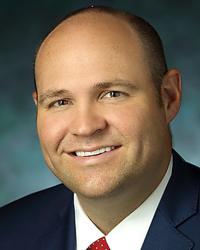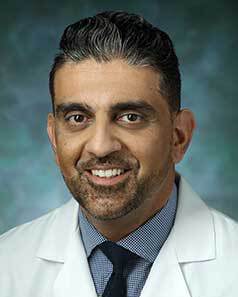-
Shadpour Demehri, MD

- Co-chair Grand Rounds committee
- Professor of Radiology and Radiological Science
-
Alex Johnson, MD

- Director of Hip Preservation, Johns Hopkins Department of Orthopaedic Surgery
- Assistant Professor of Orthopaedic Surgery
Cartilage Regeneration Clinic
Damaged cartilage due to overuse or injury can greatly impact quality of life. Johns Hopkins cartilage regeneration experts help patients with chronic knee pain get back to the activities they enjoy, while delaying or eliminating the need for joint replacement.
Why Choose Johns Hopkins
- Our team includes experts with years of experience in cartilage regeneration surgery — a complex set of procedures — who specialize in minimally invasive approaches.
- Our orthopaedic surgeons approach cartilage regeneration surgery with cutting-edge technology, incorporating the latest methods into their practice.
- Not everyone is a good candidate for cartilage regeneration. These procedures are ideal for active people under age 55. Our experienced team will assess your condition and help you make an informed decision.
Schedule an Appointment
Schedule online through MyChart
Some services may not be available for online scheduling.
Log into MyChart | Sign up for MyChart
Schedule by phone
U.S. patients: 443-997-2663
International patients: +1-410-502-7683 or fill out a form.
Cartilage Regeneration Options
Membrane-induced Autologous Chondrocyte Implantation (MACI)
MACI is a surgical procedure that uses cartilage-forming cells from your body to restore damaged cartilage in the knees. It involves a biopsy to harvest chondrocytes (cartilage-forming cells), which are allowed to multiply in a lab, and surgery to implant them into the damaged area.
Our experts use a small-punch biopsy method for cell collection, rather than a more invasive arthroscopic procedure. This approach combines two surgeries into one, reducing recovery time and cost.
Osteochondral Grafting
Osetochondral grafting is a cartilage regeneration procedure that replaces not only the cartilage but the underlying bone as well. It is often used when the cartilage is worn down to the bone. The healthy bone and cartilage used for the surgery (graft) can come from a donor (allograft) or from other areas of your body (autograft).
Osteoarticular Transfer System (OATS) Procedure
The OATS procedure, also called mosaicplasty, involves taking healthy cartilage from non-weight-bearing areas of the joint and transplanting it into the damaged areas. Because the transfer happens within the same joint, this procedure works best for small areas of damaged cartilage. Joints significantly affected by osteoarthritis may require a different approach. Since your own tissue is used, the OATS procedure eliminates risks related to allergy or transplant rejection.
Osteotomy
Osteotomy is a surgical procedure that involves cutting and/or reshaping the bone. This procedure often takes place alongside other cartilage regeneration methods. In the knee, osteotomy could be used to shift the weight off the damaged part of the joint to a healthier one, as well as to restore the joint alignment.
Contact the Johns Hopkins Cartilage Regeneration Clinic for more information about surgical options and to set up an evaluation.

